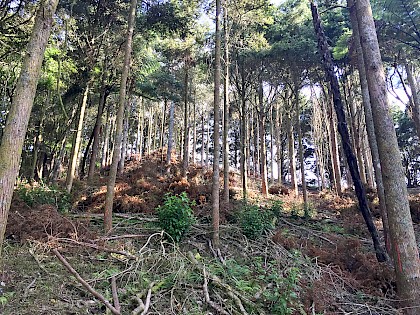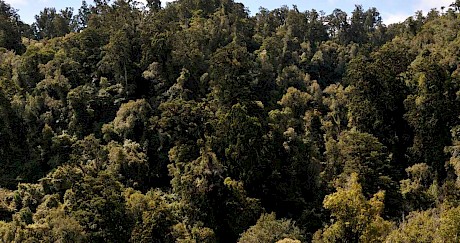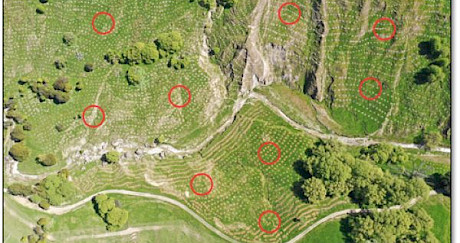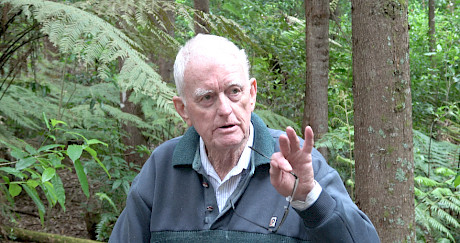Northland totara riparian projectProject Status: Completed
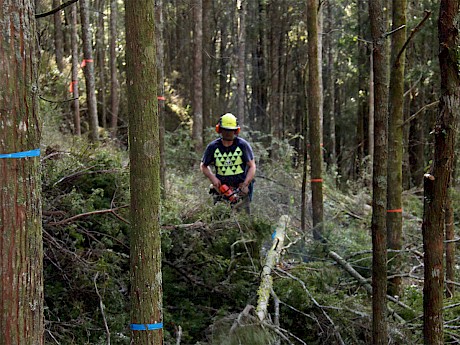 Michael Bergin thinning a PSP. This Tāne’s Tree Trust project is funded by Reconnecting Northland and demonstrates the management of native forest areas on a Northland dairy-farm, to combine productive and ecological benefits. Primarily, it focusses on managing the naturally regenerating totara stands already integrated into the gullies on the farm. But it also involves extending the area with demonstration planting for additional riparian enhancement, connectivity, fencing and silvicultural trials for biodiversity gains. The project run for 3 years until 2018.
Michael Bergin thinning a PSP. This Tāne’s Tree Trust project is funded by Reconnecting Northland and demonstrates the management of native forest areas on a Northland dairy-farm, to combine productive and ecological benefits. Primarily, it focusses on managing the naturally regenerating totara stands already integrated into the gullies on the farm. But it also involves extending the area with demonstration planting for additional riparian enhancement, connectivity, fencing and silvicultural trials for biodiversity gains. The project run for 3 years until 2018.
Background
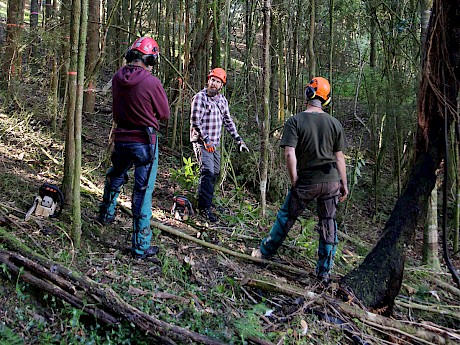 Arborist students under the expert tutelage of arboriculturalist Kent Thwaites.In Northland (and other regions), many hill farms have stands of native trees often dominated by naturally regenerating totara. Taratahi Northland Agricultural Training Centre run a training dairy-farm at Mangakahia, northwest of Whangarei. It is typical of dairy country in this region comprising hill country and river flats and with naturally regenerating totara in gullies. The farm presents excellent opportunities to demonstrate how regenerating stands of totara can be managed for future sustainable timber production and yet also address water-quality issues.
Arborist students under the expert tutelage of arboriculturalist Kent Thwaites.In Northland (and other regions), many hill farms have stands of native trees often dominated by naturally regenerating totara. Taratahi Northland Agricultural Training Centre run a training dairy-farm at Mangakahia, northwest of Whangarei. It is typical of dairy country in this region comprising hill country and river flats and with naturally regenerating totara in gullies. The farm presents excellent opportunities to demonstrate how regenerating stands of totara can be managed for future sustainable timber production and yet also address water-quality issues.
For the dairy sector, Fonterra, building on the earlier Clean Streams Accord, are currently implementing the Sustainable Dairying Water Accord which seeks a step change in the management of risks to waterways posed by dairying. As part of this Accord, the dairy sector, in collaboration with local partnerships, is committed to progressively fencing, planting and managing riparian areas to enhance water quality.
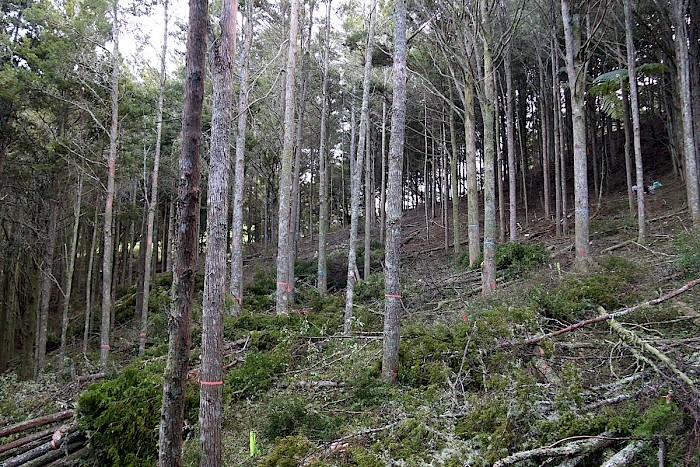 A thinned Permanent Sample Plot (PSP) within a natural stand. Note the shaded conditions in the unthinned area above this thinned plot. Growth response of the residual totara trees after thinning will be measured and also the response of understorey vegetation development to the increased light conditions. With the aim of improving water quality from intensive pastoral hill country, this project sought to demonstrate to farmers practical cost-effective initiatives to appropriately manage gully and riparian areas in forestry, and in particular native forestry. There is excellent potential to turn these stands into assets for farmers that will provide both short term farm management and environmental benefits and in the long term alternative income streams as sustainable productive stands of high value timber.
A thinned Permanent Sample Plot (PSP) within a natural stand. Note the shaded conditions in the unthinned area above this thinned plot. Growth response of the residual totara trees after thinning will be measured and also the response of understorey vegetation development to the increased light conditions. With the aim of improving water quality from intensive pastoral hill country, this project sought to demonstrate to farmers practical cost-effective initiatives to appropriately manage gully and riparian areas in forestry, and in particular native forestry. There is excellent potential to turn these stands into assets for farmers that will provide both short term farm management and environmental benefits and in the long term alternative income streams as sustainable productive stands of high value timber.
Progress to date
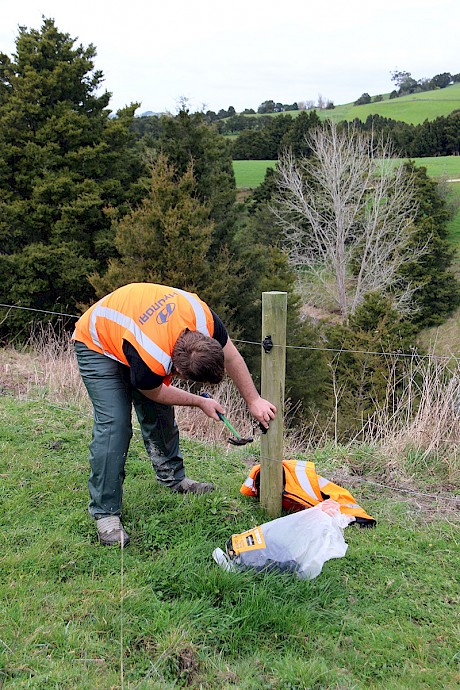 Students helped fence/repair more than 1km of fence line that now excludes livestock from 6ha of native forest in the gully area above the dam and new plantings. The first year of this 3 year project (2015) has now been successfully completed. It has been well supported by partner organisations and individuals, with significant ‘In-kind’ time/resource contributions. Student participation has been a strong feature of the first year, with workshops on water-quality monitoring and field surveys of stream health and life in the waterways complementing the native forestry aspects and the focus on management of the existing regenerating totara. There has also been a number of trial ‘firsts’ test run in this work.
Students helped fence/repair more than 1km of fence line that now excludes livestock from 6ha of native forest in the gully area above the dam and new plantings. The first year of this 3 year project (2015) has now been successfully completed. It has been well supported by partner organisations and individuals, with significant ‘In-kind’ time/resource contributions. Student participation has been a strong feature of the first year, with workshops on water-quality monitoring and field surveys of stream health and life in the waterways complementing the native forestry aspects and the focus on management of the existing regenerating totara. There has also been a number of trial ‘firsts’ test run in this work.
Work to date has included:
- The establishment of 8 Permanent Sample Plots (PSPs) & Recce plots within a 6ha area of naturally regenerating totara forest on the property. These will record responses to trials targeting both silvicultural aspects and ecological/biodiversity enhancements through management.
- Water quality testing and stream health surveying at two sites on the property.
- The thinning of 4 of the PSPs to test a theoretical management prescription for optimal growth rates (i.e. to a Stand Density Index of 25%) and as demonstration management areas. This was the first ever field-testing of a new computer model developed to help select trees/stocking rates for thinning.
- The completion of over 1km of fencing to exclude livestock from nearly 6ha of existing totara forest and the gully watercourse contained on the farm.
- The site preparation and planting of over 1900 native plants to extend the vegetated area and enhance species diversity in the gully and to demonstrate planted totara forest establishment and management (juxtaposed for comparison to management of naturally regenerated stands).
- Student workshops in the field, on water-quality monitoring and stream health, planting, and practical silviculture.
- Conducting a wider forest survey/inventory on the property and the preparation and submission of a Draft Sustainable Forest Management (SFM) Plan, under the Forests Act, for the areas of totara forest on the property. Note, this is the first external test in applying a template for “Totara SFM Plans” that has been prepared by Ministry for Primary Industries.
Outputs
Handbook Article - 11.4 Weaving resilience into our farming landscapes with native forestry
Contacts for this project
- Project Manager, Paul Quinlan
- TTT Executive Officer: Enable JavaScript to view protected content.

